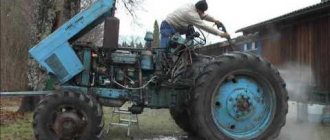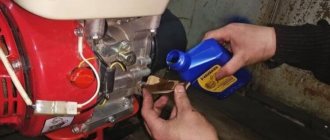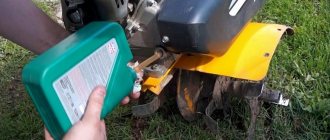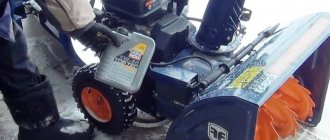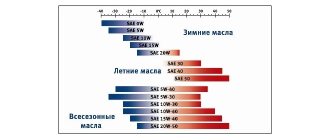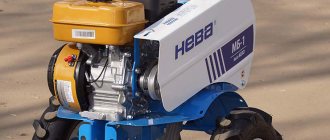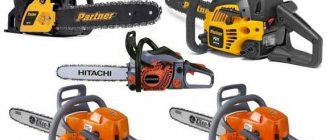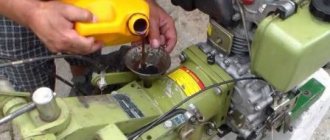Tractor T-40
The T-40 tractor (“magpie”) is a wheeled tractor produced at the Lipetsk Tractor Plant from 1961 to 1995.
Production of this model is currently discontinued. During production, over 1.196 million similar tractors were assembled. This equipment was intended for working with a mower, a snow blade, a haystack, processing row crops, plowing light soils in greenhouses, gardens and plots, and for transport work. The universal hitch in the T-40 made it possible to use various types of attachments. This tractor has become indispensable on farmsteads and farms. Thanks to the trolley and front loader, the T-40 was considered a universal agricultural machine. The model belonged to the 0.9 traction class, its engine power was 37-50 “horses”. The tractor was equipped with two types of engines: D-37 and D-144.
Thanks to the mechanical reverse transmission in the T-40, it was possible to use the entire range of forward and rear speeds. This, taking into account the wide capabilities of the tractor for aggregation with mounted and trailed machines produced for light equipment such as T-25 and heavier equipment such as MTZ-80 “Belarus”, significantly increased the possibilities for using the T-40. This is what determined the popularity of the “sorokovnik” in the USSR. Tractors of this model continue to operate on Russian and foreign farms.
Symptoms of a faulty oil pump
The first thing that will indicate problems with the oil pump is the oil pressure light coming on. In this case, the element indicates that there is a problem with the engine lubrication system. How serious they are remains to be determined by the car owner. In addition to checking the pressure, attention should be paid to oil consumption. If the pressure in the lubrication system of the power unit decreases, the vehicle should not be operated until the cause is determined and repairs are made. The main symptoms of problems in the system are a light coming on or a knocking sound in the engine.
Actions to be taken in the event of a breakdown:
- stop and turn off the engine;
- wait a while for the oil to drain into the engine crankcase, then check its level using a dipstick. If the level is minimal, you need to top it up to normal;
- start the engine;
- If the oil pressure lamp continues to light and extraneous noise is still heard from the engine, this may indicate a possible problem with the oil pump.
Big video repair
The T-40 (base model) was produced in various modifications. First of all, they differed in power units. 3 versions were produced (in addition to the basic one) with the D-37 engine:
- T-40A – all-wheel drive modification;
- T-40AN - the version had low ground clearance, as it was used for work on slopes;
- T-50A – industrial version, supplemented with a loader;
There were four modifications of the T-40 with the D-144 unit:
- T-40M – rear-wheel drive version;
- T-40AM – all-wheel drive version;
- T-40 AMN is a model with low ground clearance. Analogue version of the T-40AN with a more powerful engine;
- T-40AP is an all-wheel drive version used in public utilities.
How to replace an oil pump yourself
Having determined that the oil pump needs replacement or repair, it is necessary to remove the mechanism from the engine.
Tools for work
In order to dismantle the unit, you will need a standard motorist kit, consisting of the following list:
- keys to “10” and “13”;
- socket heads;
- extension cord;
- cardan joints.
How to remove the oil pump
If the work is carried out on an injection engine rather than a carburetor engine, then the crankshaft position sensor will need to be removed from the engine. Otherwise, dismantling the mechanism is performed in the same sequence:
- We de-energize the vehicle's on-board network by removing the “—” wire from the battery.
- Loosen the generator fasteners and remove the belt.
One of the first procedures for dismantling the oil pump is to remove the alternator belt.
After draining the oil, dismantle the engine protection and sump
To remove the crankshaft pulley, you will need to remove the timing belt.
One of the steps to dismantle the oil pump is to remove the crankshaft pulley
The oil receiver is attached to the main bearing cap with two bolts and one bolt to the oil pump
The pump is secured with six bolts, unscrew them
Having unscrewed all the fasteners, move the pump away from the main bearing cap and remove it from the engine.
Video: dismantling the oil pump on a VAZ 2108/2109
Pump installation
To perform reassembly, follow these step-by-step instructions:
- Before installing the assembly, the drive gear is installed accordingly.
Before installing the oil pump in place, the drive gear must be set in a certain position
The drive gear must align with the flats on the crankshaft
Before installing the pump, coat the working edge of the oil seal with engine oil.
After lubricating the oil seal with engine oil and installing it in its seat, install the pump
Read more: E182vg z4 d0 firmware
Video: how to install an oil pump on a VAZ with front-wheel drive
Technical characteristics of T-40
Weighing 2.595 tons, the model had relatively small dimensions: length – 3660 mm, width – 1620 mm, height – 2100 mm. The speed range of the T-40 was 2.23-26.68 km/h. The tractor also had a slow gear (speed 1.62 km/h). The ground clearance of this model was 500 mm, the track was adjustable within the range of 1200-1800 mm.
Fuel consumption of the T-40 tractor
The specific fuel consumption of the T-40 tractor depended on the type of engine. The nominal rate was 7.2 kg/hour. In some cases it increased significantly.
Additional equipment, devices
This engine can, if necessary, be equipped with a fairly extensive list of various additional equipment. First of all, it is a pneumatic compressor. The reason for this is its demand for construction equipment. This is where the D-144 is usually installed. The lubrication system of such a compressor is forced, while the cooling is passive, air.
A hydraulic system can also be mounted on this engine. Since various types of attachments are often used. For example, if the D-144 is installed on a tractor for agricultural and other work. Another fairly frequently installed additional equipment is the tachometer speedometer drive.
Engine
The T-40 was equipped with four-stroke diesel engines D-37 and D-144, which were supplied by the Vladimir Tractor Plant. The power of the D-37 was 37 hp, the D-144 was 50 hp. The engine was started using a PDV starting gasoline engine (a small number of models) or an electric starter. Later, the D-37M engine appeared, featuring an undivided combustion chamber, which ensures lower fuel consumption. The engine of the T-40 tractor consisted of a fuel and air supply system, a crank mechanism, a cooling system, a distribution mechanism, a starting device and an oil system.
On the left side of the engine there was a middle deflector, fuel equipment, exhaust and intake pipelines. On the right were the starter (starter), generator, injectors, decompressor drive mechanism, oil centrifuge and generator. In the front part there was a fan and generator drive pulley, an oil filler neck, a fan, an hour meter and a hydraulic pump.
The fuel regime in the T-40 was regulated by a throttle disk installed in front of the protective mesh of the fan and oil cooler.
When operating the tractor in cold weather, it was recommended to disconnect the radiator from the oil system and secure the throttle disc with studs in front of the fan mesh. At positive temperatures, the opposite actions were performed. The temperature could be controlled based on thermometer data.
With maintenance and timely inspection, the T-40 engine worked for a very long time.
It was prohibited:
- Heavily load a cold, recently repaired or new engine that has not been pre-tested.
- Operate the unit with reduced oil pressure.
- Operate for a long time when the engine is overloaded.
- Operate the motor without a fan shroud.
- Fill the engine with unacceptable types of oil.
- Leave the engine idling for a long time.
- Operate at low crankcase oil temperatures (below 55 degrees).
- Operate the engine with or without a faulty air cleaner.
- Operate when the engine is overheated (over 105 degrees).
Work principles
The operation of the engine is simple and is similar to other diesel engines. The engine is started using a starter. In addition, in many vehicles where the D 144 is installed, the starter is automatic, and glow plugs are used to facilitate starting. Let's consider the design of the main systems of the unit.
Supply system
The power system is not unique; no differences from similar engines are observed. Fuel is supplied using an in-line fuel pump. There are closed type nozzles and a multi-layer spray. There are 2 types of fuel filters - coarse and fine.
The advantage of filters is their versatility, since they are easy to replace and it is possible to replace them with similar ones from other engines. An air purifier is installed, which is a paper element.
Lubrication system
Lubrication is carried out in a combined way - sprayed under pressure onto the desired surfaces. The liquid is cooled in a special radiator. This eliminates the need for liquid cooling. Also, since some of the heat is lost through an additional radiator, the use of air cooling is sufficient. The system includes an engine-driven oil pump and filter.
Experience using the D-144, its strengths and weaknesses
For 2022, quite a lot of reviews have accumulated about the performance of this engine. All the pros and cons of this motor have been identified, depending on modifications and conditions of use. In part, this is precisely one of its most important advantages. Since the owner already knows what to expect from the unit after a certain period of operation and mileage.
The most significant advantages include the ease of repair of the engine itself. Many people install the D-144 not only on factory-developed tractors, but also on home-made ones. This is possible precisely because of the versatility of this motor. The generator deserves special attention. It produces three-phase current, with direct current present on one of its windings.
For this reason, there is no need to install an additional current rectifier. At the same time, the presence of a relay regulator is strictly necessary. Don’t forget about this when assembling the tractor yourself and equipping it with the D-144.
Many users highlight the fact that there is a special lever that allows you to turn the hydraulic pump on/off. Usually it is painted in a different color. In the picture below - blue.
The fuel pump is installed with a single plunger. It is due to this that quite significant fuel savings occur.
If necessary, it is possible to install additional options on the engine. These are supercharging and autonomous injection.
In addition to a large number of different advantages, there are also certain disadvantages. These primarily include:
- the exhaust manifold is made of steel, not cast iron - over time it burns out and smoke begins to escape in different directions;
- there is a spool nut on the fuel pump - getting to it without a special key is quite difficult, almost impossible;
- air cooling does not allow cooling the engine quickly enough if necessary;
- every 2-3 months it is necessary to top up the oil;
- Oil often leaks through the oil seal on the crankshaft.
